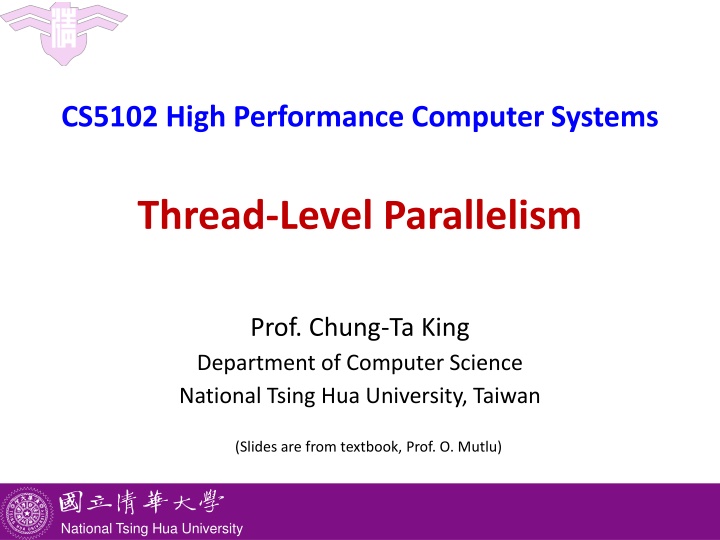
Multiprocessors and Thread-Level Parallelism in High-Performance Computer Systems
Explore the concepts of multiprocessors, thread-level parallelism, and shared-memory architectures in high-performance computer systems. Learn about the benefits of multiprocessors, types of multiprocessors, and the differences between loosely-coupled and tightly-coupled systems. Discover how synchronization and memory consistency play critical roles in enhancing performance and dependability.
Download Presentation

Please find below an Image/Link to download the presentation.
The content on the website is provided AS IS for your information and personal use only. It may not be sold, licensed, or shared on other websites without obtaining consent from the author. If you encounter any issues during the download, it is possible that the publisher has removed the file from their server.
You are allowed to download the files provided on this website for personal or commercial use, subject to the condition that they are used lawfully. All files are the property of their respective owners.
The content on the website is provided AS IS for your information and personal use only. It may not be sold, licensed, or shared on other websites without obtaining consent from the author.
E N D
Presentation Transcript
CS5102 High Performance Computer Systems Thread-Level Parallelism Prof. Chung-Ta King Department of Computer Science National Tsing Hua University, Taiwan (Slides are from textbook, Prof. O. Mutlu) National Tsing Hua University
Outline Introduction (Sec. 5.1) Centralized shared-memory architectures (Sec. 5.2) Distributed shared-memory and directory-based coherence (Sec. 5.4) Synchronization: the basics (Sec. 5.5) Models of memory consistency (Sec. 5.6) 1 National Tsing Hua University
Why Multiprocessors? Improve performance (execution time or task throughput) Reduce power consumption: 4N cores at frequency F/4 consume less power than N cores at frequency F Leverage replication, reduce complexity, improve scalability Improve dependability: redundant execution in space 2 National Tsing Hua University
Types of Multiprocessors Loosely coupled multiprocessors No shared global memory address space (processes) Multicomputer network Network-based multiprocessors Usually programmed via message passing Explicit calls (send, receive) for communication Tightly coupled multiprocessors Shared global memory address space Programming model similar to uniprocessors (i.e., multitasking uniprocessor) Threads cooperate via shared variables (memory), while operations on shared data require synchronization 3 National Tsing Hua University
Loosely-Coupled vs Tightly-Coupled Summation of elements of an array for (i = 0; i < 10000; i++) sum = sum + A[i]; For tightly-coupled multiprocessors: 10 nodes for (i = 1000*pid; i < 1000*(pid+1); i++) sum = sum + A[i]; // critical section! For loosely-coupled multiprocessors for (i=0; i<1000; i++) sum = sum + A[i]; if (pid != 0) send(0,sum); else for(i=1; i<9; i++) { receive(i,partial_sum); sum = sum + partial_sum;} 4 National Tsing Hua University
Loosely Coupled Multiprocessors Each node has private memory Cannot directly access memory on another node Use explicit send/recv to exchange data Data allocation is important IBM SP-2, cluster of workstations MPI programming Node 0 Node 1 send P P 0 N-1 0 N-1 Mem Mem $ $ NI NI Interconnection network NI NI $ $ 0 N-1 0 N-1 Mem Mem P P Node 2 Node 3 5 National Tsing Hua University
Message Passing Programming Model Local Process Address Space Local Process Address Space Recv y, P, t match address y Send x, Q, t address x Process(or) Q Process(or) P User-level send/receive abstraction Local buffer (x, y), process(or) (P, Q) and tag (t) Explicit communication, synchronization 6 National Tsing Hua University
Thread-Level Parallelism Thread-level parallelism Have multiple program counters, share address space Use MIMD model Amount of computation assigned to each thread (grain size) must be sufficiently large, as compared to array or vector processors We will focus on tightly-coupled multiprocessors Computers consisting of tightly-coupled processors whose coordination and usage are controlled by a single OS and that share memory through a shared address space If the multiprocessor is implemented on a single chip, then we have a multicore 7 National Tsing Hua University
Tightly Coupled Multiprocessors Multiple threads/processors use shared memory (address space) Communication is implicit via loads and stores Opposite of explicit message-passing multiprocessors Theoretical foundation: PRAM model P1 P2 P3 P4 Memory System 8 National Tsing Hua University
Why Shared Memory? Pros: Application sees multitasking uniprocessor Familiar programming model, similar to multitasking uniprocessor and no need to manage data allocation OS needs only evolutionary extensions Communication happens without OS Cons: Synchronization is complex Communication is implicit and indirect (hard to optimize) Hard to implement (in hardware) 9 National Tsing Hua University
Tightly Coupled Multiprocessors: 2 Types Symmetric multiprocessors (SMP) Small number of cores Share single memory with uniform memory access/latency (UMA) Fig. 5.1 10 National Tsing Hua University
UMA: Uniform Memory/Cache Access All cores have same uncontended latency to memory Latencies get worse as system grows + Data placement unimportant/less important (easier to optimize code and make use of available memory space) - Contention could restrict bandwidth and increase latency Main Memory contention in memory banks . . . long Interconnection Network latency contention in network . . . Processor Processor Processor 11 National Tsing Hua University
Tightly Coupled Multiprocessors: 2 Types Distributed shared memory (DSM) Memory distributed among processors more # of cores Non-uniform memory access/latency (NUMA) Fig. 5.2 12 National Tsing Hua University
Alternative View of DSM All local memories are addressed by a global addressing space A node can directly access memory on other nodes, using normal ld/st Nodes connected via direct (switched) or multi-hop interconnection networks Node 0 Node 1 ld P P 0 N-1 N 2N-1 Mem Mem $ $ NI NI Interconnection network NI NI $ $ 2N 3N-1 3N 4N-1 Mem Mem P P Node 2 Node 3 13 National Tsing Hua University
NUMA: NonUniform Memory/Cache Access Shared memory as local versus remote memory + Low latency, high bandwidth to local memory - Much higher latency to remote memories - Performance very sensitive to data placement Interconnection Network long contention in network latency . . . Memory Memory Memory short latency Processor Processor . . . Processor 14 National Tsing Hua University
Caveats of Parallelism Amdahl s Law f: Parallelizable fraction of a program N: Number of processors 1 Speedup = f + 1 - f N Maximum speedup limited by serial portion: serial bottleneck Parallel portion is usually not perfectly parallel Synchronization overhead (e.g., updates to shared data) Load imbalance overhead (imperfect parallelization) Resource sharing overhead (contention among N cores) 15 National Tsing Hua University
Bottlenecks in Parallel Portion Synchronization: operations manipulating shared data cannot be parallelized Locks, mutual exclusion, barrier synchronization Communication: tasks may need values from each other Causes thread serialization when shared data is contended Load imbalance: parallel tasks have different lengths Imperfect parallelization or microarchitectural effects Reduces speedup in parallel portion Resource contention: parallel tasks can share hardware resources, delaying each other Replicating all resources (e.g., memory) expensive Additional latency not present when each task runs alone 16 National Tsing Hua University
Issues in Tightly Coupled Multiprocessors Exploiting parallelism in applications Long latency of remote access Shared memory synchronization Locks, atomic operations Cache coherence and memory consistency Ordering of memory operations What should programmer expect hardware to provide? Resource sharing, contention, partitioning Communication: interconnection networks Load imbalance 17 National Tsing Hua University


